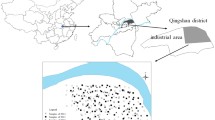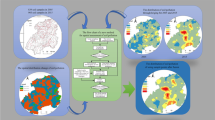Abstract
Mapping the space–time distribution of heavy metals in soils plays a key role in contaminated site classification under conditions of in situ uncertainty, whereas uncertainty assessment is based on the quantification of the specific uncertainties in terms of exceedance probabilities. Geostatistical space-time kriging (STK) is increasingly used to estimate pollutant concentrations in soils. Sequential indicator simulation (SIS) technique is popular in uncertainty assessment of heavy metal contamination of soils. However, these techniques cannot handle multi-temporal data. In this work, spatiotemporal sequential indicator simulation (STSIS) based on an additive space–time semivariogram model (STSIS_A) and on a non-separable space–time semivariogram model (STSIS_NS) was used to assimilate multi-temporal data in the mapping and uncertainty assessment of heavy metal distributions in contaminated soils. Cu concentrations in soils sampled during the period 2010–2014 in the Qingshan district (Wuhan City, Hubei Province, China) were used as the experimental data set. Based on a number of STSIS realizations, we assessed different kinds of mapping uncertainty, including single-location uncertainty during 1 year and during multiple years, multi-location uncertainty during 1 year, and during multiple years. The comparison of the STSIS technique vs. SIS and STK techniques showed that STSIS performs better than both STK and SIS.







Similar content being viewed by others
References
Bai, J., Huang, L., Yan, D., Wang, Q., Gao, H., Xiao, R., & Huang, C. (2011). Contamination characteristics of heavy metals in wetland soils along a tidal ditch of the Yellow River Estuary, China. Stochastic Environmental Research and Risk Assessment, 25(5), 671–676.
Broos, M. J., Aarts, L., van Tooren, C. F., & Stein, A. (1999). Quantification of the effects of spatially varying environmental contaminants into a cost model for soil remediation. Journal of Environmental Management, 56, 133–145.
Christakos, G. (1992). Random field models in earth sciences. San Diego, CA: Acad Press.
Christakos, G., Angulo, J. M., & Yu, H.-L. (2011). Constructing space-time pdf distributions in geosciences. Boletín Geológico y Minero de España (BGME), 122(4), 531–542.
Emery, X. (2004). Properties and limitations of sequential indicator simulation. Stochastic Environmental Research and Risk Assessment, 18, 414–424.
Giaccio, L., Cicchella, D., DeVivo, B., et al. (2012). Does heavy metal pollution affects semen quality in men? A case of study in the metropolitan area of Naples (Italy). Journal of Geochemical Exploration, 112, 218–225.
Goovaerts, P. (2001). Geostatistical modeling of uncertainty in soil science. Geoderma, 103, 3–26.
Goovaerts, P., & Journel, A. G. (1995). Integrating soil map information in modeling the spatial variation of continuous soil properties. European Journal of Soil Science, 46, 397–414.
Guagliardi, H., Cicchella, D., & Rosa, R. D. (2012). A geostatistical approach to assess concentration and spatial distribution of heavy metals in urban soils. Water Air Soil Pollution, 223, 5983–5998.
Guo, G. H., Wu, F. C., Xie, F. Z., et al. (2012). Spatial distribution and pollution assessment of heavy metals in urban soils from southwest China. Journal of Environmental Sciences, 24(3), 410–418.
Imperato, M., Adamo, P., Naimo, D., et al. (2003). Spatial distribution of heavy metals in urban soils of Naples city (Italy). Environmental Pollution, 124, 247–256.
Iqbal, J., & Shah, M. H. (2011). Distribution, correlation and risk assessment of selected metals in urban soils from IsImabad Pakistan. Journal of Hazardous Material, 192, 887–889.
Jang, C.-S., Liang, C.-P., & Wang, S.-W. (2013). Integrating the spatial variability of water quality and quantity to probabilistically assess groundwater sustainability for use in aquaculture. Stochastic Environmental Research and Risk Assessment, 27(6), 1281–1291.
Johnson, C. C., & Ander, E. L. (2008). Urban geochemical mapping studies: how and why we do them. Environmental Geochemistry and Health, 30, 511–530.
Jost, G., Heuvelink, G. B. M., & Papritz, A. (2005). Analysing the space-time distribution of soil water storage of a forest ecosystem using spatio-temporal kriging. Geoderma, 128, 258–273.
Juang, K. W., & Lee, D. Y. (1998). Simple indicator kriging for estimating the probability of incorrectly delineating hazardous areas in a contaminated site. Environ Science and Technology, 32, 2487–2493.
Juang, K. W., Chen, Y. S., & Lee, D. Y. (2004). Using sequential indicator simulation to assess the uncertainty of delineating heavy-metal contaminated soils. Environmental Pollution, 127, 229–238.
Kolovos, J., Christakos, G., Hristopulos, D. T., & Serre, M. L. (2004). Methods for generating non-separable spatiotemporal covariance models with potential environmental applications. Advances in Water Resources, 27, 815–830.
Korre, A. (1999). Statistical and spatial assessment of soil heavy metal contamination in areas of poorly recorded, complex sources of pollution. Stochastic Environmental Research and Risk Assessment, 13(4), 288–316.
Morton-Bermea, O., Hernández-Álvarez, E., González-Hernández, G., et al. (2009). Assessment of heavy metal pollution in urban topsoils from the metropolitan area of Mexico City. Journal of Geochemical Exploration, 101, 218–224.
National Environmental Protection Agency of China. 1995. Environmental Quality Standards for Soils (GB 15618–1995).
Ofelia, M. B., Elizabeth, H. A., & Rufino, L. (2010). Spatial distribution of heavy metals in top soils around the industrial facilities of Cromatos de Mexico, Tultitlan Mexico. Bulletin of Environmental Contamination and Toxicology, 85(5), 520–524.
Qu, M. K., Li, W. D., & Zhang, C. R. (2013). Assessment the risk costs in delineating soil nickel contamination using sequential Gaussian simulation and transfer functions. Ecological Informatics, 13, 99–105.
Sheng, J. J., Wang, X. P., Gong, P., et al. (2012). Heavy metals of the Tibetan top soils. Environmental Science and Pollution Research, 19, 3362–3370.
Smith, J. L., Halvorson, J. J., & Papendick, R. L. (1993). Using multiple-variable indicator kriging for evaluating soil quality. Soil Science Society of America Journal, 57, 743–749.
Snepvangers, J. J. J. C., Heuvelink, G. B. M., & Huisman, J. A. (2003). Soil water content interpolation using spatio-temporal kriging with external drift. Geoderma, 112, 253–271.
Soltani, F., Afzal, P., & Asghari, O. (2014). Delineation of alteration zones based on Sequential Guassian Simulation and concentration-volume fractal modeling in the hypogene zone of Sungun copper deposit NW Iran. Journal of Geochemical Exploration, 140, 64–76.
Wang, G., Gertner, G., Parysow, P., & Anderson, A. B. (2000). Spatial prediction and uncertainty analysis of topographic factors for the revised universal soil loss equation (RUSEL). Journal of Soil Water Conservation, 55, 374–384.
Webster, R., & Oliver, M. A. (1989). Optimal interpolation and isarithmic mapping of soil properties: VI. Disjunctive kriging and mapping the conditional probability. Journal of Soil Science, 40, 497–512.
Webster, R., & Oliver, M. A. (2007). Geostatistics for environmental scientists (2nd Edition). Ltd, New York, NY: J. Wiley & Sons.
Yang, Y., Li, W. D., & He, L. Y. (2011). Uniform expression of variogram nested model and parameter estimation in spatial prediction of soil properties. Trans. of the CSAE, 27(6), 85–89.
Zhao, Y. C., Shi, X. Z., Yu, D. S., Wang, H. J., & Sun, W. X. (2005). Uncertainty assessment of spatial patterns of soil organic carbon density using sequential indicator simulation, a case study of Hebei province, China. Chemoshpere, 59, 1527–1535.
Acknowledgments
The research was supported by National Natural Science Foundation of China (Grant No. 41101193), the Fundamental Research Funds for the Central Universities (Grant No. 2662014PY062), and China Scholarship Council. Opinions in the paper do not constitute an endorsement or approval by the funding agencies and only reflect the personal views of the authors.
Author information
Authors and Affiliations
Corresponding author
Rights and permissions
About this article
Cite this article
Yang, Y., Christakos, G. Uncertainty assessment of heavy metal soil contamination mapping using spatiotemporal sequential indicator simulation with multi-temporal sampling points. Environ Monit Assess 187, 571 (2015). https://doi.org/10.1007/s10661-015-4785-y
Received:
Accepted:
Published:
DOI: https://doi.org/10.1007/s10661-015-4785-y




